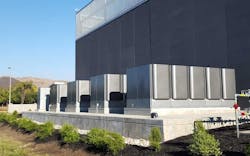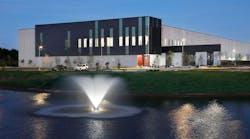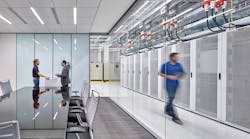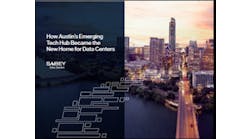SAN JOSE, Calif. – The four rows of silver cubes glimmer in the afternoon sun, sitting inconspicuously behind a data center in the southern end of Silicon Valley. These Bloom Energy Server fuel cells, powered entirely by methane biogas, are a symbol of a much larger vision for an Internet powered by sustainable energy.
Equinix, the world’s largest provider of colocation services, plans to shift its entire global data center network to run on clean and renewable energy. It’s an ambitious goal, and will require years of work and a variety of new approaches to energy management.
The installation of Bloom boxes at the SV5 data center are one way Equinix is attacking this challenge. It reflects the growing shift toward sustainable practices in the data center industry, which is an enormous user of electric power. In 2014 Equinix consumed more than 2,200 gigawatt hours of energy across its platform of 100 data centers in 33 countries.
As world leaders gather in Paris to seek a collective solution to climate change, some corporations joining the cause. Equinix announced Monday that it has adopted the American Business Act on Climate Pledge, joining more than 140 companies to demonstrate an ongoing commitment to climate action at this week’s COP21 Paris negotiations. In addition to on-site fuel cells, the company has purchased massive amounts of solar and wind energy to support its data centers.
“Equinix has a responsibility to power the digital world in a sustainable way,” said Sam Kapoor, chief global operations officer for Equinix. “Our pledge is another commitment to help make our long-term goal of operating our portfolio of data centers using 100 percent clean and renewable energy a reality.”
The New Frontier: Beyond Energy Efficiency
Electricity is the lifeblood of every data center. The shift toward renewable energy marks the second phase of the data center industry’s effort to address its massive use of energy. The first phase focused on energy efficiency, applying innovation in data center design to slash consumption of grid energy. The second phase is a tougher challenge, as the data center sector must work with – and sometimes work around – a U.S. utility industry that has been slow to embrace renewable energy.
Hyperscale data center operators like Google, Facebook, Apple and Amazon have been the leading players in sourcing “green” electricity to power their massive data centers, prompted both by internal commitments and external prodding. On Thursday, Google announced plans to buy 842 megawatts of renewable energy capacity to power its data centers.
“With world leaders coming together at the COP21 UN conference on climate change in Paris this week, there’s no better time to focus on renewable energy,” said Urs Hölzle, Google’s Senior VP for Technical Infrastructure. “We hope that our efforts play a small part in boosting all of us in the race to solve climate change.”
“Customers and end users of cloud companies are saying ‘this is part of our value system,’” Kava continued. “They want to know where the energy that’s powering their cloud is coming from.”
Google has pursued utility-scale power purchase agreements (PPAs) with generators of solar and wind power, bringing new renewable energy onto the grids supporting its data centers. Amazon has announced plans to source 80 megawatts of renewable energy from a solar farm in Virginia, and is also testing a new 4.8 megawatt Tesla stackable battery unit. Apple operates huge photovoltaic solar energy arrays at several of its facilities, as well as Bloom fuel cells.
Multi-Tenant Market: Challenges and Opportunities
But the multi-tenant data center market has been a tougher sell. Customers are focused on reliability and cost, and have historically been resistant to making any tradeoffs to source renewable energy. Because colocation facilities server many customers in the same data hall, they can see wide variability in power loads and server utilization. In a 2014 report, the Natural Resources Defense Council cited the multi-tenant market as an area offering the potential for enormous sustainability gains.
“We see great leaders in the cloud space, but we need the whole industry to participate,” Pierre Delforge, director of high-tech energy efficiency at the NRDC, told Data Center Knowledge. “The efficiency debate hasn’t been considered as much in the multi-tenant space. This sector is growing rapidly, faster than the rest of the market. It presents both opportunities and barriers. When you move from onsite to colocation, you’re leveraging economies of scale and expertise and gain energy efficiency. However, in the long term it adds a layer of misaligned incentives.”[clickToTweet tweet=”The shift to clean energy is the second phase of the data center industry’s sustainability push. ” quote=”The shift to clean energy is the second phase of the data center industry’s sustainability push. “]
Attention from the NRDC and Greenpeace, which began ranking multi-tenant providers in its 2015 ranking of data center firms, has helped move the needle. Recently, corporate social responsibility programs have incentivized customers to consider “green” energy in their outsourced IT operations.
Digital Realty, the largest player in the wholesale data center market, has launched a Clean Start program that provides new tenants with renewable energy certificates (RECs) to offset the energy they will use during their lease. Digital Realty will procure the RECs for one year at no additional cost to the tenant.
“Our goal is to give clients an effortless path to procure clean, renewable energy for their data centers, and to take a leadership role in reducing the environmental footprint for the data center industry,” said Aaron Binkley, director of sustainability at Digital Realty.
2015: The Year of Green Energy for Equinix
For Equinix, 2015 has been a year of huge strides on the sustainability front. In April, the company announced its commitment to use 100 percent “clean and renewable” energy in its colocation facilities.
“As a data center industry leader, we believe the choices we make about our energy consumption can have a broad impact,” writes David Rinard. Senior Director of Global Sustainability & Procurement at Equinix.
A long row of colocation cages inside the Equinix SV5 data center in San Jose, Calif. (Photo: Rich Miller)
Equinix has moved quickly to put major investment behind its green commitments. The company has pursued several strategies, including the purchase of renewable energy credits (RECs), buying renewably-sourced power from utilties when it is available, using power purchase agreements with renewable energy generation firms, and on-site generation.
At the time of its April announcement, the company sourced about 30 percent of its energy from renewable sources. In September, Equinix signed a power purchase agreement (PPA) with SunEdison for 105 megawatts of new solar power, enough to cover the power usage of all 11 of the company’s California data centers as well as its Redwood City, Calif. headquarters. The deal increased the use of clean energy to 43 percent of its global footprint.
In November, Equinix signed PPAs with NextEra Energy Resources and Invenergy to purchase a combined 225 megawatts of wind energy in Oklahoma and Texas, enough to cover all Equinix data centers throughout North America. The deal will nearly double the company’s use of renewable energy, to 82 percent of its global footprint by the end of 2016.
The company has also worked to buy renewable power from utilities that offer it, like Palo Alto Utilities, which provides 100 percent renewable power to the Equinix SV8 data center.
“Better Electrons” from Bloom Energy
Equinix is among a small number of data center providers that have pursued on-site clean power. One of the leading players in this niche is Sunnyvale-based Bloom Energy, whose “Bloom boxes” support about 150 megawatts of mission-critical IT operations at data centers operated by eBay, Apple, CenturyLink, AT&T, Verizon and NTT America.
The Bloom Energy Server uses solid oxide fuel cell technology that converts fuel to electricity through an electro-chemical reaction, without any combustion. It can work with either natural gas or biofuels, such as biogas from landfills.
Bloom says that its on-site fuel cells offer “better electrons” by making more efficient use of fuel than coal-fired power plants, eliminating power loss during distribution, and sharply reducing emissions. The Bloom boxes offer a better carbon profile than most utility power, and can be used with renewable energy to create a carbon-neutral solution.
Each of these banks of Bloom fuel cells provides 250kW of power for Equinix, which has four of these units at its San Jose data center campus. (Photo: Rich Miller)
Equinix says the Bloom units at its SV5 data center in San Jose will avoid at least 1.6 million pounds of carbon dioxide emissions from the California grid. The four 250 kW fuel cells went online last month, and their performance and reliability will be evaluated over time as Equinix considers its options for future expansion of on-site power generation.
The fuel cells will produce an estimated 8.3 million kilowatt hours of renewable energy per year. The company says SOx (sulfur oxides), NOx (nitrogen oxides) and other harmful smog-forming particulate emissions are virtually eliminated with the use of Bloom Energy fuel cells. And because 1 MW of demand at a local gas or coal-fired power plant is avoided, the fuel cells also offer indirect water savings.
The Bloom box installation at SV5 includes uninterruptible power modules that are configured to protect a portion of the data center’s energy load from electrical outages, reducing reliance on traditional back-up equipment.
“This project demonstrates Equinix’s commitment to find cost-effective ways to reduce our carbon footprint and move toward 100 percent renewable energy,” said Kapoor. “By working with Bloom Energy to purchase 100 percent biogas and fuel cells, we’re able to support the energy needs of our customers in an environmentally responsible way.”
Equinix is also evaluating photovoltaiic solar arrays, deploying a 342 kW solar system at its SG3 International Business Exchange in Singapore.
Principles to Guide the Future
By the end of 2016, these efforts will bring Equinix’s use of clean energy to more than 80 percent of its current data center footprint. But the company continues to build new data center, and in 2016 will also integrate data centers from its pending acquisition of European provider TelecityGroup.
That’s why Equinix has adopted a set of Renewable Energy Principles to guide its future power sourcing. From Equinix:
- We prefer to utilize renewable and low carbon energy.
- We prefer local sources of energy.
- We prefer new or recently built energy sources.
- We seek favorable renewable energy policies when locating new data centers.
- We will provide regular updates on our sustainability goals and progress to improve focus and transparency
“The pace of adoption may vary as we work toward 100 percent renewable sources” said Rinard. “But our commitment is that in all markets, and at all times, we will be good environmental stewards and use our leadership position to inspire lasting change.”






